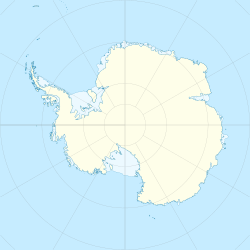Duroch Islands facts for kids
|
Location in Antarctica
|
|
| Geography | |
|---|---|
| Location | Antarctica |
| Coordinates | 63°18′S 57°54′W / 63.300°S 57.900°W |
| Area | 5 km2 (1.9 sq mi) |
| Administration | |
| Administered under the Antarctic Treaty System | |
| Demographics | |
| Population | Uninhabited |
The Duroch Islands are a group of small islands and rocks. They are located in Antarctica, about 1 kilometer (0.6 miles) off Cape Legoupil. This cape is on the northern coast of the Trinity Peninsula. The islands cover an area of about 5 square kilometers (1.9 square miles).
These islands were first discovered by a French expedition. This journey was led by Captain Jules Dumont d'Urville between 1837 and 1840. He named one of the larger islands "Rocher Duroch." This name honored Ensign Joseph Duroch, who served on d'Urville's ship, the Astrolabe. Later, in 1946, the Falkland Islands Dependencies Survey explored the islands. They suggested that the name Duroch should be used for the whole group of islands. The Duroch Islands are also very close to Chile's Bernardo O'Higgins Station. This station is an important research base in Antarctica.
A Special Home for Birds
The Duroch Islands are a very important place for many birds. BirdLife International has named this island group an Important Bird Area (IBA). This means it's a critical spot for bird populations.
Penguin Colonies
The islands are home to large breeding colonies of several types of penguins. These include:
- Adélie penguins: About 800 pairs of these penguins live and raise their young here.
- Chinstrap penguins: There are around 9,400 pairs of chinstraps on the islands.
- Gentoo penguins: About 3,500 pairs of gentoo penguins make their nests here.
These large numbers show how important the Duroch Islands are for these amazing Antarctic birds.
Exploring the Islands and Rocks
The Duroch Islands group includes several smaller islands. These have been named over time by different expeditions.
Named Rocks
Some of the coastal rocks in the island group also have their own names. These were mapped and named by the Chilean Antarctic Expedition.
- Agurto Rock: This rock is also known as Islote Agurto. It lies just off the coast. Its name first appeared on a Chilean government map in 1959.
- Silvia Rock: This rock is located southeast of Agurto Rock. It is about 0.3 nautical miles (0.6 km) north of Cape Legoupil.
- Rosa Rock: This rock is found about 0.1 nautical miles (0.2 km) west of Agurto Rock.
The Silvia and Rosa Rocks were named after Sylvia González Markmann and Rosa Gonzalez de Claro. They were the daughters of Gabriel González Videla, who was the President of Chile at the time.


